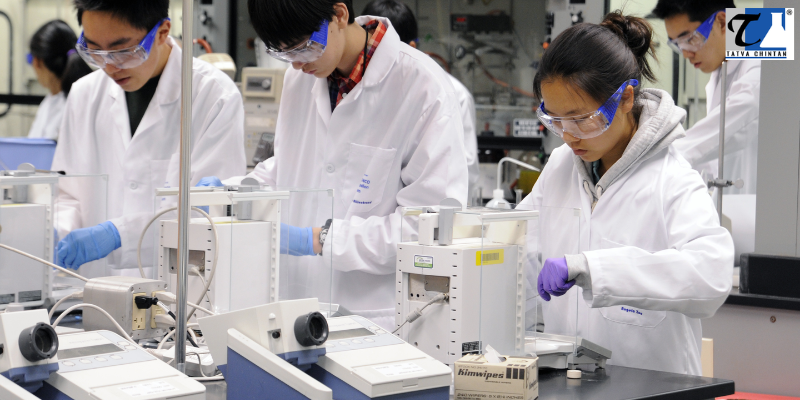List the Specifications of PTC Products
A phase-transfer catalyst (PTC) and two liquid phases are contained in a phase-transfer catalyst system. When the PTC is transferred between these two phases, it drives the formation of the product in one step and regenerates itself in the other phase. There are different types of PTC products, each with unique properties.
PTC Products and their Properties
Heterogeneous organic reactions are frequently observed in organic synthesis. These processes typically involve slow rates, limited yields, and incomplete reactivity. But an inorganic salt dissolves the organic substance in a polarity-limited organic solvent. The reaction continues without any issues when quaternary ammonium salt is supplied in tiny amounts.
PTC is the name for the material that moves negatively charged ions between two phases and speeds up the rate of reaction. To put it another way, PTCs are a kind of catalyst that can help transfer reactants from one phase to another that are capable of reacting, hence accelerating the rate of a heterogeneous system's reaction as a result of the transfer of reactants between them.
PTC products and their attributes are shown below:
1. Tetra Methyl Ammonium Hydroxide Pentahydrate
Tetra Methyl Ammonium Hydroxide Pentahydrate is a polarographic reagent and ion-pairing agent used in analytical chemistry. It also has uses in gas chromatography or mass spectrometry (GC/MS), capillary zone electrophoresis, capillary isotachophoresis, and liquid chromatography.
Additionally, iron oxide nanoparticles are made using the air-sensitive compound Tetra Methyl Ammonium Hydroxide Pentahydrate. Tetra methyl ammonium dithiocarboxylic acid and magnetic resonance imaging contrast agents benefit from using these nanoparticles. It acts as an etchant or developer in the semiconductor and photoelectric sectors.
Tetra Methyl Ammonium Hydroxide Pentahydrate is hygroscopic and must be stored in a tightly closed container in a dry, well-ventilated location.
Additionally, strong acids and oxidizing agents cannot be used with this PTC product.
2. Tetra Butyl Ammonium Bromide
Tetra Butyl Ammonium Bromide is a PTC used in the process of cyclizing potassium salt to produce lactones. Along with the N-alkylation of aromatic carboxamides, it also participates in the Curtius rearrangement.
As an ionic liquid, Tetra Butyl Ammonium Bromide is crucial for regioselective O-alkylation. Additionally, it is used to make single-component electrochemical green-light-emitting cells and polymer solar cells.
In addition, if the material is hygroscopic, keep the container tightly closed and in a dry, well-ventilated location. Tetra Butyl Ammonium Bromide is not compatible with potent oxidizing agents.
3. Tetra Butyl Ammonium Perchlorate
Among the other products used as PTC, Tetra Butyl Ammonium Perchlorate is generally employed as a supporting electrolyte for polarographic measurements.
Like the other PTC products already mentioned, Tetra Butyl Ammonium Perchlorate is hygroscopic. Therefore, the storage container should be tightly closed in a well-ventilated and dry place. In addition, Tetra Butyl Ammonium Perchlorate is not compatible with organic materials or reducing agents.
4. Tetra Butyl Ammonium Fluoride Trihydrate
As a mild base and a source of fluoride ions in an organic solvent, Tetra Butyl Ammonium Fluoride Trihydrate is another product used as a PTC. In addition, it can also be used as a deprotecting agent to get rid of silyl ether-protecting groups.
It is a reactant in synthesizing cellulose derivatives, deprotecting agents, and lipophilic peptides in vivo DNA transfections and dehydrobromination reactions. In addition, when O-silylated enolates are exposed to dimethyl sulfoxide, Tetra Butyl Ammonium Fluoride Trihydrate is crucial for transforming those molecules into carbonyls.
Tetra Butyl Ammonium Fluoride Trihydrate is also hygroscopic. Therefore, you should keep the container tightly closed in a dry, well-ventilated area. Potent oxidizing agents cannot be used with it.
5. Tetra Butyl Ammonium Trifluoro Methane Sulfonate
Tetra Butyl Ammonium Trifluoro Methane Sulfonate is used as a PTC for the condensation reactions of carboxylic acids and alcohols. It is also used in Friedel-Crafts reactions and other reactions like the reaction of aromatic compounds with sulfonyl chlorides, the cracking of alkanes, the alkylation of alkenes, the isomerization of alkanes, the trans-alkylation of aromatics, and trans-bromination.
It is because it acts as a substance that transfers negative ions between two phases and speeds up the rate of reaction. Due to its hygroscopic nature, Tetra Butyl Ammonium Trifluoro Methane Sulfonate should be stored in a cool, dry, and well-ventilated environment. Keep away from oxidizing substances, air, and water when storing.
6. Tetra Ethyl Ammonium Tetrafluoroborate
The phase transfer catalyst Tetra Ethyl Ammonium Tetrafluoroborate, used in organic synthesis processes, is an excellent PTC. It is used as an electrolyte additive when the polyphenols in grape seed extracts are separated using capillary electrophoresis.
Additionally, it is used to make other aqueous solutions of tetra butyl ammonium salts. The synthesis of conducting poly is accomplished using tetraethylammonium tetrafluoroborate. Tetra Ethyl Ammonium Tetrafluoroborate is also a hygroscopic substance. A strong oxidizing agent should not be used with this product.
7. Tetra Butyl Ammonium Tetrafluoroborate
Another product used in a phase-transfer catalyst system is Tetra Butyl Ammonium Tetrafluoroborate, which is commonly used as a pharmaceutical intermediate. Tetra Butyl Ammonium Tetrafluoroborate, an organic molten salt, can be used as the stationary phase to create long-lasting and reasonably efficient open tubular columns.
Tetra Butyl Ammonium Tetrafluoroborate needs to be kept in a cool location for storage. Additionally, the container must be kept dry and well-ventilated with a tightly closed lid.
8. Tetra Butyl Ammonium Phosphate
Tetra Butyl Ammonium Phosphate is another PTC used in organic synthesis. The simultaneous analysis of the maleate of water-soluble vitamins and chlorpheniramine is used as a counter-ion in an ion-pair reagent in high-performance liquid chromatography.
It is additionally employed in HPLC as a buffering reagent. The separation of deoxycholic acid and chenodeoxycholic acid is also accomplished with Tetra Butyl Ammonium Phosphate used as a mobile phase additive in two-dimensional reversed-phase high-performance thin-layer chromatography.
Conclusion
Phase transfer catalysts speed up reactions between heterogeneously distributed, immiscible phases. Many products are used as PTCs in organic synthesis, and some have been discussed already.






Comments
Post a Comment